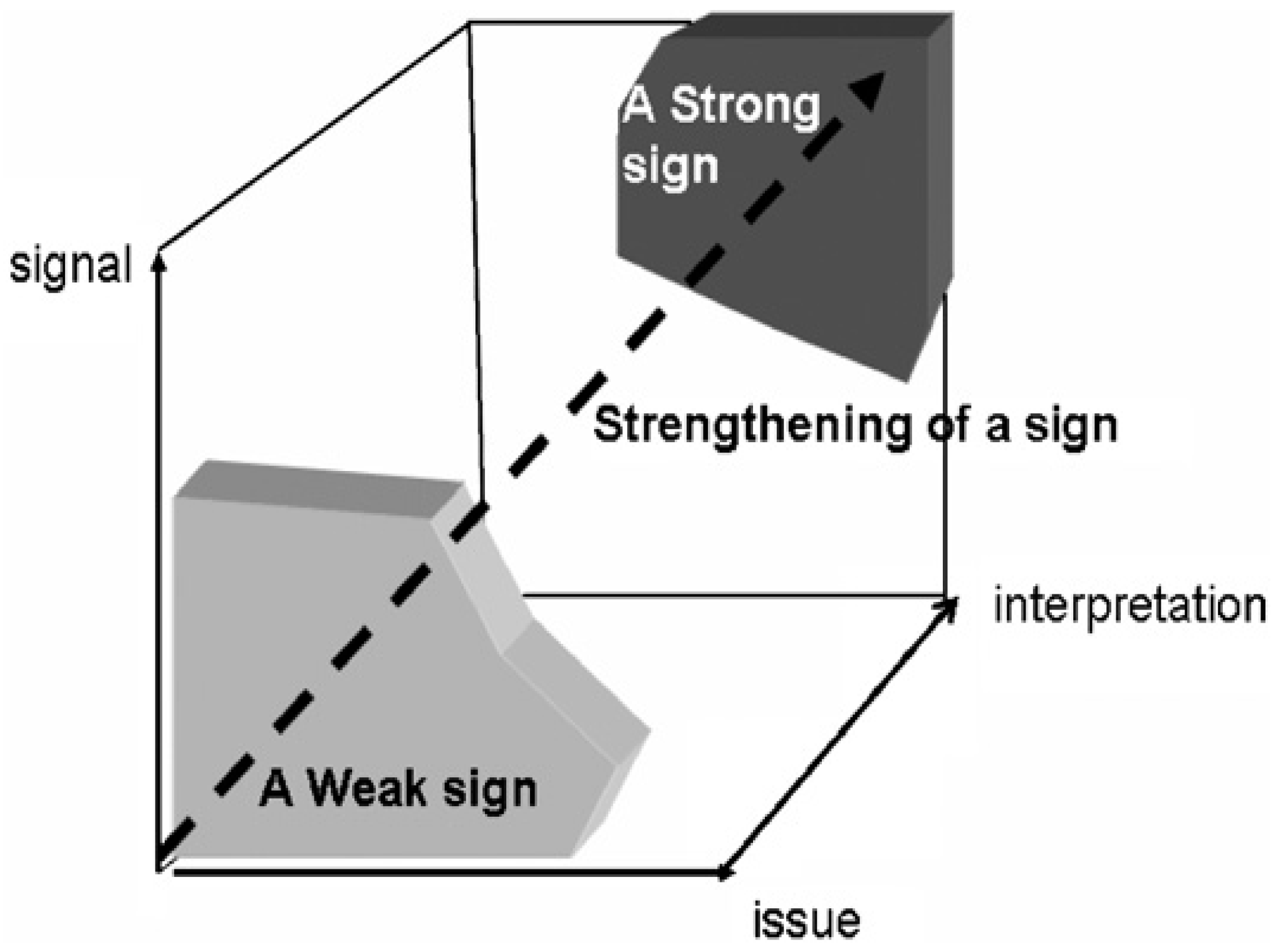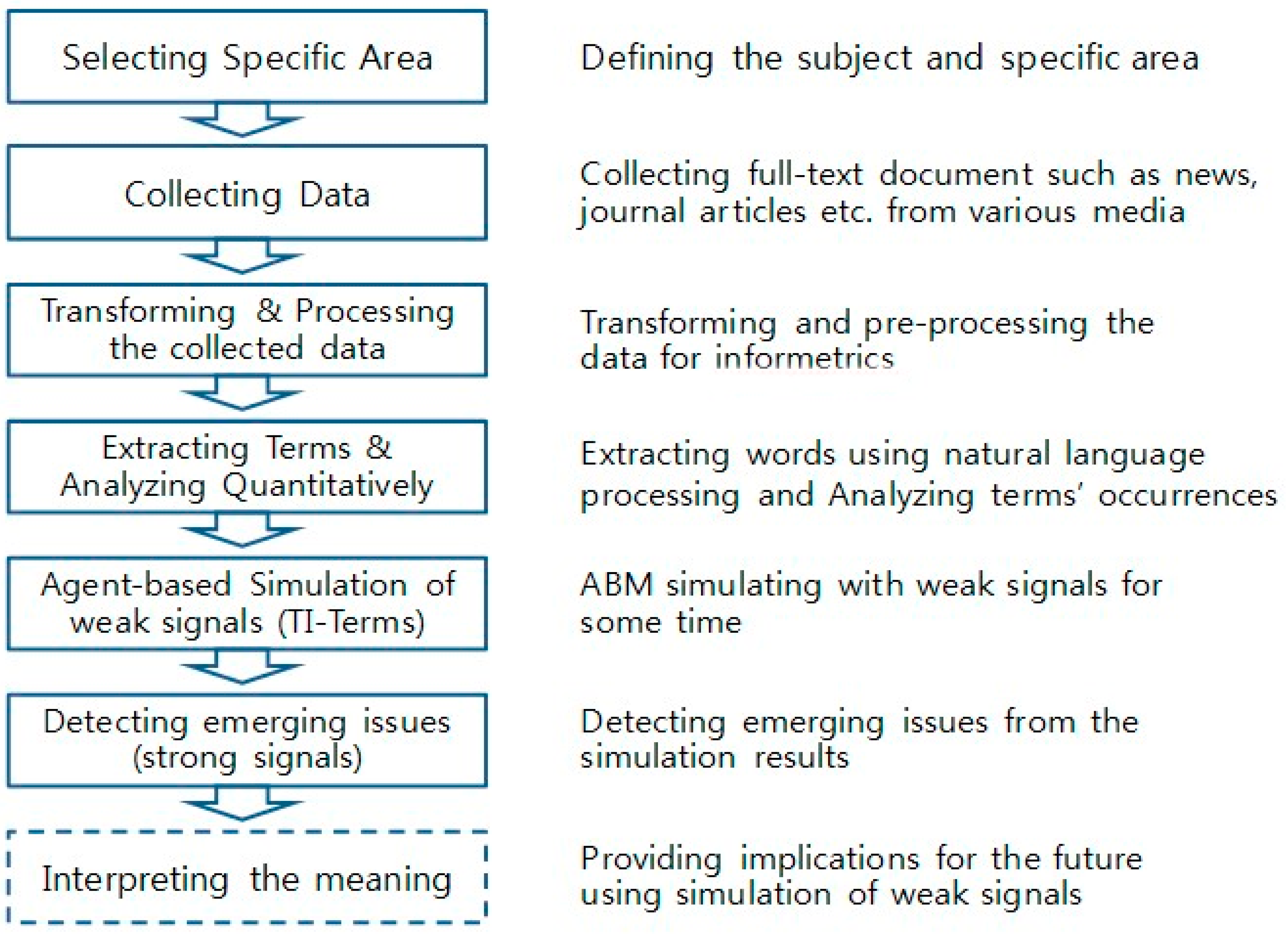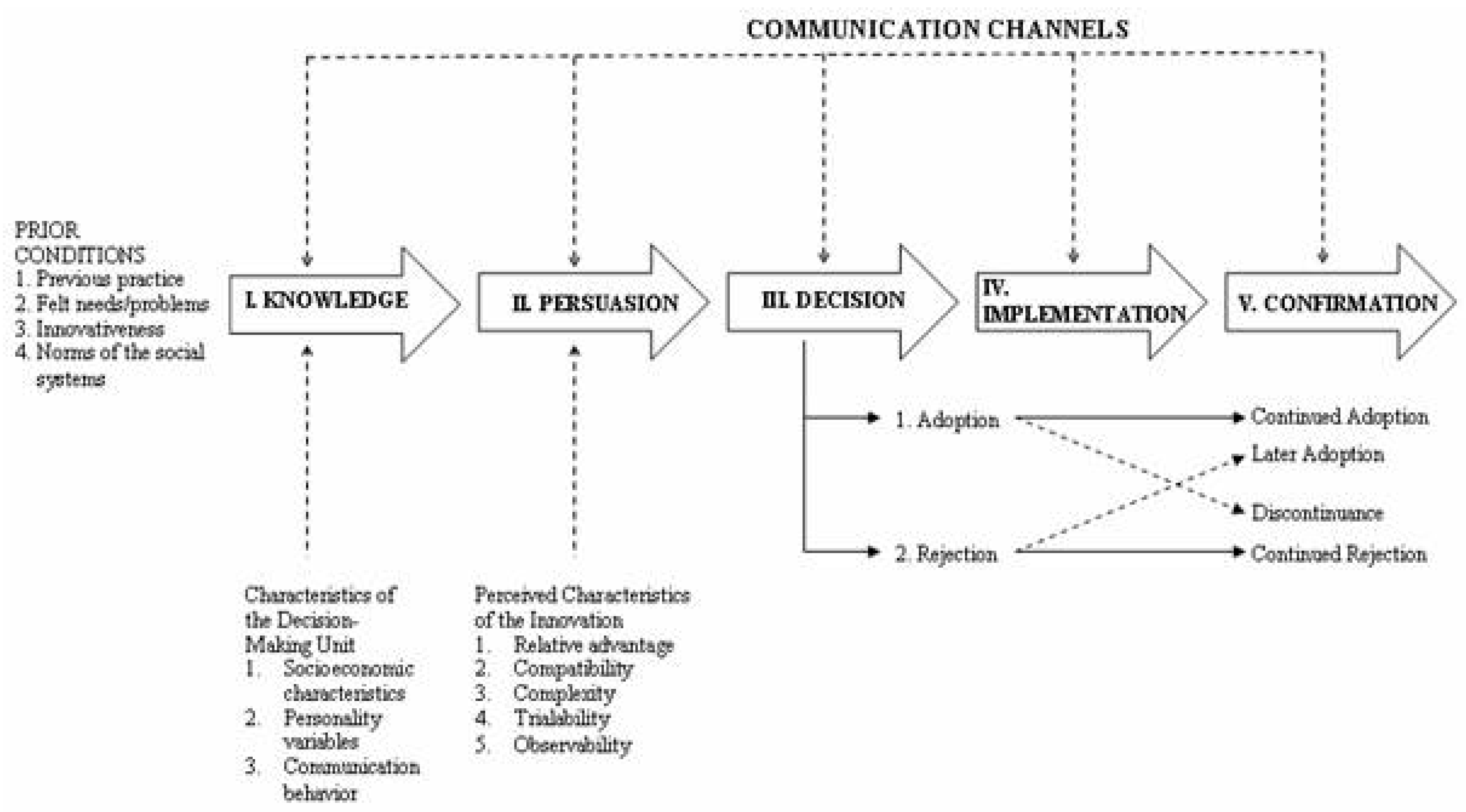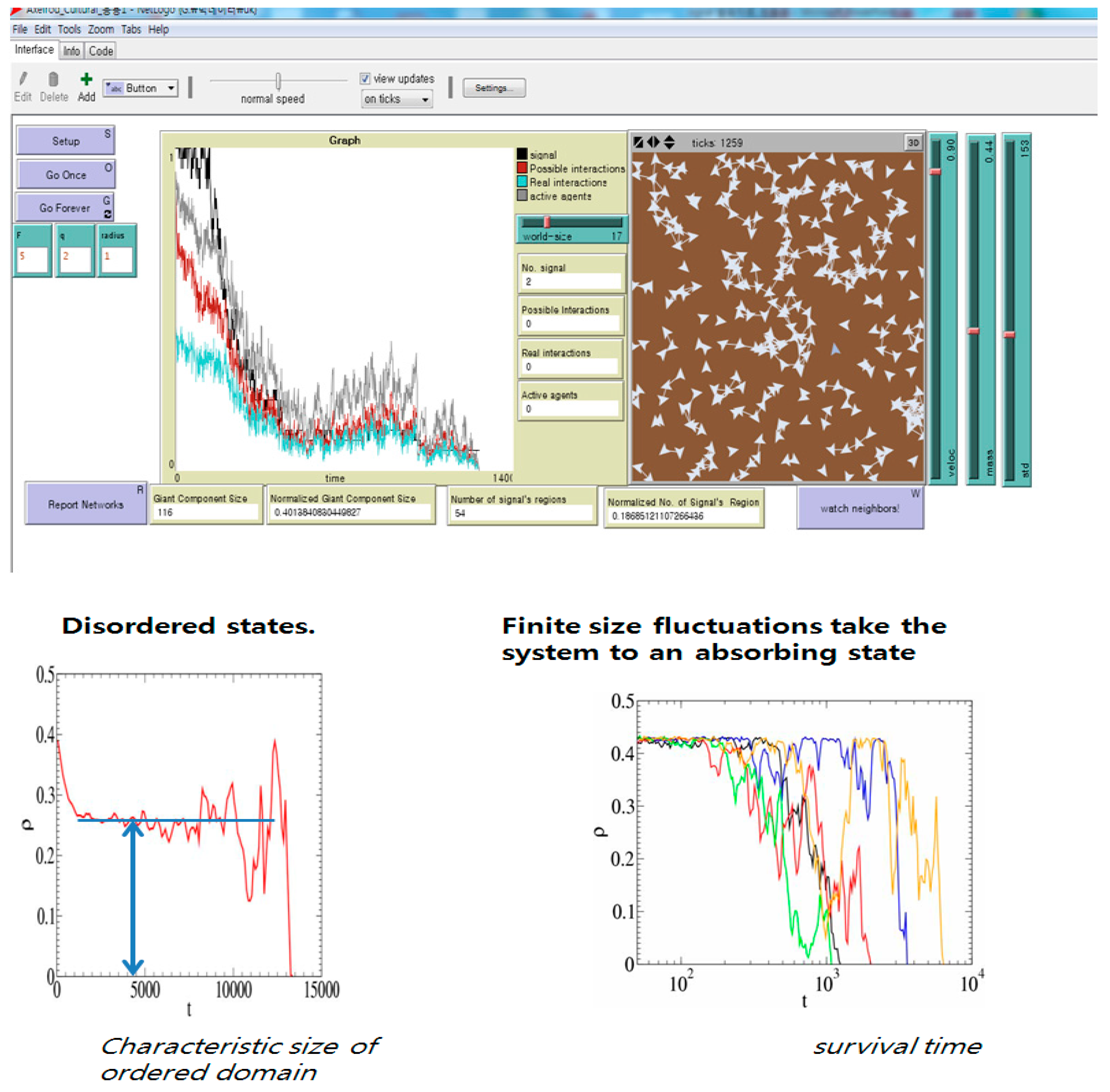Simulation of Weak Signals of Nanotechnology Innovation in Complex System
Abstract
:1. Introduction
2. Background
2.1. Complexity Models of Innovation
2.1.1. Fitness Landscapes
2.1.2. Complex Networks
2.1.3. Percolation
2.2. Identification of Weak Signals and Signal Tracing
3. Methodology
- Agent-based modeling: Mechanisms of change are specified for local actors, and the consequences of these mechanisms are examined to discover the emergent properties of the system when many actors interact. Computer simulation is especially helpful for this bottom-up approach, but its use predates the availability of personal computers.
- No central authority: Consistent with the agent-based approach is the lack of a central coordinating agent in the model. Although important aspects of cultures can be standardized, canonized, and disseminated by powerful authorities, the present model deals with the process of social influence before or alongside the actions of such authorities. It seeks to understand how much culture emergence and stability can be explained without resorting to the coordinating influence of centralized authority.
- Adaptive rather than rational agents: The individuals are assumed to follow simple rules about giving and receiving influence. These rules are not necessarily derivable from any principle of rational calculation based on costs and benefits, or forward-looking strategic analysis typical of the game theory. Instead, the agents simply adapt to their environment.
4. Text Mining Analysis of Technological Innovation: Case Study
4.1. Data Collection
4.2. Processing Data
4.3. Quantitative Analysis of Searching Weak Signals
5. Structure of the Simulation Model
5.1. Innovation Indicators
5.2. Design of the Simulation Model
5.2.1. Netlogo Model: Axelrod’s Cultural Dissemination
5.2.2. Description of Simulation
5.3. Simulation of Weak Signals
5.4. Weak Signal Search and Interpretation
6. Conclusions
Acknowledgments
Author Contributions
Conflicts of Interest
References
- Fisher, J.C.; Pry, R.H. A simple substitution model of technical change. Technol. Forecast. Soc. Chang. 1971, 3, 75–81. [Google Scholar] [CrossRef]
- Arthur, W.B. Competing technologies, increasing returns, and lock-in by historical events. Econ. J. 1989, 99, 116–131. [Google Scholar] [CrossRef]
- Bruckner, E.; Ebeling, W.; Jiménez Montãno, M.A.; Scharnhorst, A. Nonlinear stochastic effects of substitution—An evolutionary approach. J. Evolut. Econ. 1996, 6, 1–30. [Google Scholar] [CrossRef]
- Dalle, J.M. Heterogeneity vs. externalities in technological competition: A tale of possible technological landscapes. J. Evolu. Econ. 1997, 7, 395–413. [Google Scholar] [CrossRef]
- Bikhchandani, S.; Hirshleifer, D.; Welch, I. Learning from the behavior of others: Conformity, fads, and informational cascades. J. Econ. Perspect. 1998, 12, 151–170. [Google Scholar] [CrossRef]
- Winter, S.G. Schumpeterian competition in alternative technological regimes. J. Econ. Behav. Org. 1984, 5, 287–320. [Google Scholar] [CrossRef]
- Silverberg, G.; Verspagen, B. Learning, innovation and economic growth: A long-run model of industrial dynamics. Ind. Corp. Chang. 1994, 3, 199–223. [Google Scholar] [CrossRef]
- Klepper, S. Entry, exit, growth and innovation in the product life cycle. Am. Econ. Rev. 1996, 86, 562–583. [Google Scholar]
- Malerba, F.; Nelson, R.R.; Orsenigo, L.; Winter, S.G. History friendly models of industry evolution: The case of the computer industry. Ind. Corp. Chang. 1999, 8, 3–40. [Google Scholar] [CrossRef]
- Fagiolo, G.; Dosi, G. Exploitation, exploration and innovation in a model of endogenous growth with locally interacting agents. Struct. Chang. Econ. Dyn. 2003, 14, 237–273. [Google Scholar] [CrossRef]
- Cowan, R. Network Models of Innovation and Knowledge Diffusion, MERIT Research Memorandum RM2004-016. 2004. Available online: www.merit.unu.edu (accessed on 2 May 2013).
- Dawid, H. Agent-based models of innovation and technological change. In Handbook of Computational Economics II: Agent-Based Computational Economics; Tesfatsion, L., Judd, K., Eds.; 2004; in press. [Google Scholar]
- Pyka, A.; Fagiolo, G. Agent-Based Modelling: A Methodology for Neo-Schumpeterian Economics; Discussion Paper Series 272; Department of Economics, University of Augsburg: Augsburg, Germany, 2005. [Google Scholar]
- Llerena, P.; Lorentz, A. Alternative Theories on Economic Growth and the Co-Evolution of Macro-Dynamics and Technological Change: A Survey; LEM Working Paper 2003/28; Laboratory of Economics and Management (LEM): Pisa, Italy, 2004. [Google Scholar]
- Silverberg, G. Long waves: Conceptual, empirical and modelling issues. In The Elgar Companion to Neo-Schumpeterian Economics; Hanusch, H., Pyka, A., Eds.; Edward Elgar: Cheltenham, UK, 2003; Available online: www.merit.unu.edu (accessed on 2 May 2013).
- Windrum, P. Neo-Schumpeterian simulation models. In The Elgar Companion to Neo-Schumpeterian Economics; Hanusch, H., Pyka, A., Eds.; Edward Elgar: Cheltenham, UK, 2004; Available online: www.merit. unu.edu (accessed on 2 May 2013).
- Ansoff, I.H. Strategic Response in Turbulent Environments; Working Paper No. 82–35; European Institute for Advanced Studies in Management: Brussels, Belgium, 1982. [Google Scholar]
- Ansoff, I.H. Implanting Strategic Management; Prentice Hall: Englewood Cliffs, NJ, USA, 1984. [Google Scholar]
- Thorleuchter, D.; Scheja, T.; Van den Poel, D. Semantic weak signal tracing. Expert Syst. Appl. 2014, 41, 5009–5016. [Google Scholar] [CrossRef]
- Ansoff, I.H. Contrib Title: Strategic issues management. Strateg. Manag. J. 1980, 1, 131–148. [Google Scholar] [CrossRef]
- Hiltunen, E. The future sign and its three dimensions. Futures 2008, 40, 247–260. [Google Scholar] [CrossRef]
- Decker, R.; Wagner, R.; Scholz, S.W. An internet-based approach to environmental scanning in marketing planning. Mark. Intell. Plan. 2005, 23, 189–200. [Google Scholar] [CrossRef]
- Uskali, T. Paying attention to weak signals: The key concept for innovation journalism. Innov. J. 2005, 2, 19. [Google Scholar]
- Yoo, S.H.; Park, H.W.; Kim, K.H. A study on exploring weak signals of technology innovation using informetrics. J. Technol. Innov. 2009, 17, 109–130. [Google Scholar]
- Tabatabei, N. Detecting Weak Signals by Internet-Based Environmental Scanning. Master’s Thesis, Waterloo University, Waterloo, Belgium, 2011. [Google Scholar]
- Thorleuchter, D.; Van den Poel, D. Weak signal identification with semantic web mining. Expert Syst. Appl. 2013, 40, 4978–4985. [Google Scholar] [CrossRef] [Green Version]
- Schwarz, J.O. Pitfalls in implementing a strategic early warning system. Futures Stud. 2005, 7, 22–31. [Google Scholar]
- Yoon, J. Detecting weak signals for long-term business opportunities using text mining of web news. Expert Syst. Appl. 2012, 39, 12543–12550. [Google Scholar] [CrossRef]
- Atkinson, A.B.; Stiglitz, J.E. A new view of technological change. Econ. J. 1969, 79, 573–578. [Google Scholar] [CrossRef]
- Frenken, K. Technological Innovation and Complexity Theory. Econ. Innov. New Technol. 2006, 15, 137–155. [Google Scholar] [CrossRef]
- Axelrod, R.; Mitchell, W.; Thomas, R.E.; Bennett, D.S.; Bruderer, E. Coalition formation in standard-setting alliances. Manag. Sci. 1995, 41, 1493–1508. [Google Scholar] [CrossRef]
- Duysters, G.; Hagedoorn, J. Internationalization of corporate technology through strategic partnering: An empirical investigation. Res. Policy 1996, 25, 1–12. [Google Scholar] [CrossRef]
- Powell, W.W.; Koput, K.W.; Smith-Doerr, L. Interorganizational collaboration and the locus of innovation: Networks of learning in biotechnology. Adm. Sci. Quart. 1996, 41, 116–145. [Google Scholar] [CrossRef]
- Hagedoorn, J. Inter-firm R&D partnerships: An overview of major trends and patterns since 1960. Res. Policy 2002, 31, 477–492. [Google Scholar]
- Pyka, A.; Kuppers, G. (Eds.) Innovation Networks: Theory and Practice; Edward Elgar: Cheltenham, UK, 2002. [Google Scholar]
- Breschi, S.; Lissoni, F. Mobility and Social Networks: Localised Knowledge Spillovers Revisited; Working Paper 142; Comercial University of Luigi Bocconi: Milano, Italy, 2003. [Google Scholar]
- Stauffer, D.; Aharony, A. Introduction to Percolation Theory; Taylor and Francis: London, UK, 1994. [Google Scholar]
- Grebel, T. Entrepreneurship: A New Perspective; Routledge: London, UK; New York, NY, USA, 2004. [Google Scholar]
- Silverberg, G.; Verspagen, B. A percolation model of innovation in complex technology spaces. J. Econ. Dyn. Control 2005, 29, 225–244. [Google Scholar] [CrossRef]
- Ansoff, I.H. Managing strategic surprise by response to weak signals. Calif. Manag. Rev. 1975, 18, 21–33. [Google Scholar] [CrossRef]
- Mendonca, S.; Cardoso, G.; Caraca, J. The strategic strength of weak signal analysis. Futures 2012, 44, 218–228. [Google Scholar] [CrossRef]
- Kuosa, T. Futures signals sense-making framework (FSSF): A start-up tool to analyse and categorise weak signals, wild cards, drivers, trends, and other types of information. Futures 2010, 42, 42–48. [Google Scholar] [CrossRef]
- Mendonca, S.; Pina e Cunha, M.; Kaivo-oja, J.; Ruff, F. Wild cards, weak signals and organisational improvisation. Futures 2004, 36, 201–218. [Google Scholar] [CrossRef]
- Holopainen, M.; Toivonen, M. Weak signals: Ansoff today. Futures 2012, 44, 198–205. [Google Scholar] [CrossRef]
- Hamilton, J.D. Time Series Analysis; Princeton University Press: Princeton, NJ, USA, 1994. [Google Scholar]
- Graff, M.; Escalante, H.J.; Cerda-Jacobo, J.; Gonzalez, A.A. Models of performance of time series forecasters. Neurocomputing 2013, 122, 375–385. [Google Scholar] [CrossRef]
- Rodpongpung, S.; Niennattrakul, V.; Ratanamahatana, C.A. Selective subsequence time series clustering. Knowl.-Based Syst. 2012, 35, 361–368. [Google Scholar] [CrossRef]
- Seol, H.; Lee, S.; Kim, C. Identifying new business areas using patent information: A DEA and text mining approach. Expert Syst. Appl. 2011, 38, 2933–2941. [Google Scholar] [CrossRef]
- Ilmola, L.; Kuusi, O. Filters of weak signals hinder foresight: Monitoring weak signals efficiently in corporate decision-making. Futures 2006, 38, 908–924. [Google Scholar] [CrossRef]
- Kerr, C.; Mortara, L.; Phaal, R.; Probert, D. A conceptual model for technology intelligence. Int. J. Technol. Intell. Plan. 2006, 2, 73–93. [Google Scholar] [CrossRef]
- Dator, J.A. Advancing Futures: Futures Studies in Higher Education; Praeger Publishers: Santa Barbara, CA, USA, 2002. [Google Scholar]
- Axelrod, R. The Dissemination of Culture: A Model with Local Convergence and Global Polarization. J. Confl. Resolut. 1997, 41, 203–226. [Google Scholar] [CrossRef]
- Flache, A.; Macy, M.W. Local Convergence and Global Diversity: From Interpersonal to Social Influence. J. Confl. Resolut. 2011, 55, 970–995. [Google Scholar] [CrossRef]
- Lim, J.Y.; Yoo, S.H.; Won, D.K. A Human-Needs-Based Dynamics to Simulate Technology Policy and Its Effects on Both Business Success and Human Happiness. Sustainability 2016, 8, 1225. [Google Scholar] [CrossRef]
- Yoo, S.H.; Won, D.K. Exploring Weak Signals of Technology Innovation of a Specific Area Using Informetrics. J. Next Gener. Inf. Technol. 2013, 4, 174–178. [Google Scholar]
- Rogers, E.M. Diffusion of Innovations, 5th ed.; Communication Books; Free Press: New York, NY, USA, 2003. [Google Scholar]
- Won, D.K.; Lim, J.Y.; Yoo, S.H. Study of an Agent-Based Model of Imagination and Development (I&D) for Innovation in the Creative Economy. Asia Pac. J. Innov. Entrep. 2013, 7, 93–111. [Google Scholar]
- Won, D.K.; Yoo, S.H.; Yoo, H.S.; Lim, J.Y. Complex adaptive systems approach to Sewol ferry disaster in Korea. J. Open Innov. Technol. Mark. Compl. 2015, 1, 22. [Google Scholar] [CrossRef]
- Yun, J.H.J.; Won, D.K.; Park, K.B. Dynamics from open innovation to evolutionary change. J. Open Innov. Technol. Mark. Compl. 2016, 2, 7. [Google Scholar] [CrossRef]




| Term | Annual Occurrences | Annual Occurrences (Normalization) | Annual Growth Rate | ||||||
|---|---|---|---|---|---|---|---|---|---|
| 09 | 10 | 11 | 12 | 09 | 10 | 11 | 12 | ||
| Carbon | 2 | 0 | 0 | 99 | 0.22 | 0.00 | 0.00 | 8.25 | 2.34 |
| Composite | 1 | 0 | 35 | 40 | 0.11 | 0.00 | 3.18 | 3.33 | 2.11 |
| Filler | 1 | 0 | 0 | 28 | 0.11 | 0.00 | 0.00 | 2.33 | 1.76 |
| Adsorption | 1 | 6 | 0 | 24 | 0.11 | 0.46 | 0.00 | 2.00 | 1.62 |
| Coating film | 3 | 0 | 38 | 70 | 0.33 | 0.00 | 3.45 | 5.83 | 1.60 |
| Calcination | 1 | 0 | 1 | 18 | 0.11 | 0.00 | 0.09 | 1.50 | 1.38 |
| Nanoparticles | 2 | 7 | 48 | 34 | 0.22 | 1.31 | 4.36 | 2.83 | 1.34 |
| Powder | 1 | 0 | 0 | 16 | 0.11 | 0.00 | 0.00 | 1.33 | 1.29 |
| Dispersion stability | 1 | 0 | 0 | 15 | 0.11 | 0.00 | 0.00 | 1.25 | 1.24 |
| Grain growth | 2 | 4 | 0 | 21 | 0.22 | 0.31 | 0.00 | 1.75 | 0.99 |
| Decomposition | 3 | 20 | 6 | 27 | 0.33 | 1.54 | 0.55 | 2.25 | 0.89 |
| Catalyst | 2 | 23 | 1 | 18 | 0.22 | 1.77 | 0.09 | 1.50 | 0.89 |
| Crystal grain | 4 | 13 | 14 | 34 | 0.44 | 1.00 | 1.27 | 2.83 | 0.85 |
| Low temperature | 1 | 7 | 0 | 8 | 0.11 | 0.54 | 0.00 | 0.67 | 0.82 |
| Chain | 1 | 2 | 1 | 8 | 0.11 | 0.15 | 0.09 | 0.67 | 0.82 |
| Microsphere | 1 | 1 | 0 | 7 | 0.11 | 0.08 | 0.00 | 0.58 | 0.74 |
| Liquid phase | 1 | 3 | 1 | 7 | 0.11 | 0.23 | 0.09 | 0.58 | 0.74 |
| Nanotube | 3 | 0 | 0 | 18 | 0.33 | 0.00 | 0.00 | 1.50 | 0.65 |
| Densification | 3 | 1 | 4 | 18 | 0.33 | 0.08 | 0.36 | 1.50 | 0.65 |
| Resin | 1 | 0 | 2 | 6 | 0.11 | 0.00 | 0.18 | 0.50 | 0.65 |
| Insulation | 1 | 0 | 0 | 6 | 0.11 | 0.00 | 0.00 | 0.50 | 0.65 |
| Chamber | 1 | 1 | 8 | 6 | 0.11 | 0.08 | 0.73 | 0.50 | 0.65 |
| Remain | 1 | 5 | 1 | 5 | 0.11 | 0.38 | 0.09 | 0.42 | 0.55 |
| Mass ratio | 1 | 0 | 1 | 5 | 0.11 | 0.00 | 0.09 | 0.42 | 0.55 |
| Penetration | 1 | 6 | 4 | 5 | 0.11 | 0.46 | 0.36 | 0.42 | 0.55 |
| Chemicals | 1 | 0 | 4 | 5 | 0.11 | 0.00 | 0.36 | 0.42 | 0.55 |
| Strength | 8 | 31 | 24 | 39 | 0.89 | 2.38 | 2.18 | 3.25 | 0.54 |
| Precipitate | 4 | 4 | 0 | 19 | 0.44 | 0.31 | 0.00 | 1.58 | 0.53 |
| Plasma | 16 | 48 | 14 | 65 | 1.78 | 3.69 | 1.27 | 5.42 | 0.45 |
| Gas | 1 | 5 | 4 | 4 | 0.11 | 0.38 | 0.36 | 0.33 | 0.44 |
| Bulk | 1 | 1 | 4 | 4 | 0.11 | 0.08 | 0.36 | 0.33 | 0.44 |
| Amorphous | 1 | 0 | 1 | 4 | 0.11 | 0.00 | 0.09 | 0.33 | 0.44 |
| Relative density | 1 | 1 | 0 | 4 | 0.11 | 0.08 | 0.00 | 0.33 | 0.44 |
| Biological | 1 | 0 | 0 | 4 | 0.11 | 0.00 | 0.00 | 0.33 | 0.44 |
| Fiber | 1 | 90 | 26 | 4 | 0.11 | 6.92 | 2.36 | 0.33 | 0.44 |
| Category | Words * |
|---|---|
| 1 | low-temperature, insulation, plasma, mass ratio |
| 2 | Chain, precipitation, amorphous |
| 3 | Mass, filler, gas, biology, carbon, densification, absorption, spectrum, crystal |
| 4 | Bulk, process, induction, insulation, grain |
© 2018 by the authors. Licensee MDPI, Basel, Switzerland. This article is an open access article distributed under the terms and conditions of the Creative Commons Attribution (CC BY) license (http://creativecommons.org/licenses/by/4.0/).
Share and Cite
Yoo, S.H.; Won, D. Simulation of Weak Signals of Nanotechnology Innovation in Complex System. Sustainability 2018, 10, 486. https://doi.org/10.3390/su10020486
Yoo SH, Won D. Simulation of Weak Signals of Nanotechnology Innovation in Complex System. Sustainability. 2018; 10(2):486. https://doi.org/10.3390/su10020486
Chicago/Turabian StyleYoo, Sun Hi, and DongKyu Won. 2018. "Simulation of Weak Signals of Nanotechnology Innovation in Complex System" Sustainability 10, no. 2: 486. https://doi.org/10.3390/su10020486




